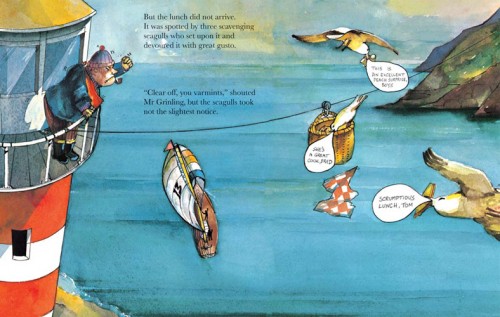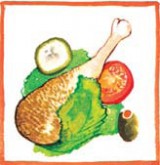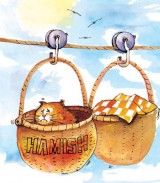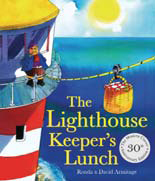Sue Cowley takes The Lighthouse Keeper’s Lunch as inspiration for four fun-filled, ocean-themed activities...
The Lighthouse Keeper’s Lunch, by Ronda and David Armitage, is a brilliant book for inspiring classroom activities around the topic of the sea, its history and the brave people who keep us safe at the seaside and away from dry land. The wonderful vocabulary within the story is in itself a great reason for choosing this book to start your topic. Words such as ‘industrious’, ‘concocts’ and ‘brazen’ help this tale trip off your tongue. Get your children thinking about what these new words mean, using the sound and the context to help them work it out.

The book tells the story of Mr Grinling, the lighthouse keeper, and the trouble his wife has getting his lunch across from the mainland. Mrs Grinling prepares her husband a delicious lunch, but the seagulls keep eating it before it reaches him. After several failed attempts, she finally manages to foil the pesky birds with some mustard flavoured sandwiches!
For a really special trip towards the end of your topic, find your local lifeboat station via the RNLI website - http://www.rnli.org.uk - and organise a visit for your children. There are also lots of great lesson ideas and resources around the theme of lifeboats and the sea on the ‘Shorething’ website - visit http://www.rnli.org.uk/Shorething/Adults. The activities here would work well with a Y2 class, but could easily be adapted for younger or older pupils.
 Design a bird-proof basket…
Design a bird-proof basket…
Talk with the children about the different methods Mrs Grinling tries in her attempts to foil the seagulls. What is her plan in each case, and why does the mustard work best in the end? Now divide the children into pairs or groups, and ask them to come up with some alternative plans for stopping the seagulls eating the lunch. Encourage them to think creatively and to come up with wild and unusual ideas, as well as the more obvious suggestions.
The children could redesign the basket so that it is ‘seagull proof’, exploring a range of different materials and designs before examining which one would work best. But they might also come up with something else to go in the basket/lunch to put the seagulls off - lateral thinking is the key!
Next, get your children to plan a menu for the most delicious lunch they can think of, to go in their seagull proof basket. Look at the food that Mrs Grinling prepares in the story - do they agree that it’s delicious? What kind of food would they want in their ‘ideal’ lunch? If possible, get the children to test some of their ideas for getting the lunch safely across to the lighthouse, setting up a line in your classroom, similar to that which runs over to the lighthouse.
Finally, ask each group to present their ideas to the class. Have they found a better solution than Mrs Grinling? Is their lunch more delicious than the one that Mrs Grinling made? Take a whole class vote to decide on the winning group, and then re-write the story, using the alternative lunch, and an ending which features your winning ‘seagull proofing’ idea.
 Build a working lighthouse…
Build a working lighthouse…
Use the lighthouse in the book as a starting point for a design and technology activity. Get the children to study a variety of lighthouses and talk about the requirements for an effective design. What are the main elements of a lighthouse design and why is it built in this way? What kind of things does a lighthouse need to withstand? What colours are used for lighthouses and why might these colours have been chosen?
Once the children have created their designs, offer the class a variety of resources with which to make a three-dimensional model. Get your pupils to include the seascape which surrounds the lighthouse, as well as the lighthouse itself. Offer a range of materials to choose from, and encourage your children to think about texture as well as colour, and to work in three dimensions. Supply them with cardboard rolls and sheets of various shapes and sizes, collage materials such as sand and cotton wool, paints, sticky plastic, crepe paper, cellophane or clear film for the lantern so that the light will shine through it, and so on.
Once their lighthouses are built, show the children how to make a complete circuit with a battery, wire and bulb. They should then work out how to fix this into their lighthouse model, so that the light appears at the top inside the lantern section. More able, or older, pupils could explore various options for getting their light to rotate inside the lighthouse.
Resources:
• Detailed information about lighthouses: http://en.wikipedia.org/wiki/Lighthouse
• Stunning lighthouse pictures: http://abduzeedo.com/amazing-pictures-lighthouses
 Recount a daring rescue story…
Recount a daring rescue story…
Introduce your children to the story of Grace Darling, an early heroine of lighthouse keepers and lifeboats. There’s a fantastic animated version of the story on the RNLI website here: http://www.rnli.org.uk/Shorething/Youth/Grace/story.aspx. Ask your class to re-tell the story, creating a dramatised version of the exciting events of the night when Grace Darling helped rescue the survivors. Avery effective way to re-tell the story is as a series of frozen images, with sea and storm sound effects added to create atmosphere.
Talk about what it means to be ‘brave’. Can your children give examples where they have seen or heard about someone doing something ‘brave’? What can they do on a smaller scale that is brave in their day-to-day lives?
 Play pirates and sing sea shanties…
Play pirates and sing sea shanties…
Extend your sea topic into the history of the sea by looking at boats from history, and at the pirates who have roamed the seas throughout history. Ask your children to brainstorm all their ideas about pirates. What kind of image do they have of pirates? What did they look like? What did they do? What kind of people were they? Compare the children’s feelings about pirates with their impressions from the Grace Darling story: what does being ‘brave’ actually mean?
The themes of pirates is a rich source for activities in art, drama and music. Your children will love the chance to design pirate costumes, to dress up as pirates, to perform some pirate songs to an assembly or at a school show. Teach your class some sea shanties, and find out more about the origin of these songs.
Resources:
• A classic shanty - http://www.nurseryrhymes4u.com/NURSERY_RHYMES/Page_521.html
• Pirates and sea shanties - http://www.elizabethan-era.org.uk/the-pirate-song.htm
• More about pirates - http://www.thekidswindow.co.uk/News/Pirates.htm
• Information from the National Maritime Museum - http://www.nmm.ac.uk/explore/sea-and-ships/facts/ships-and-seafarers/pirates
 The Lighthouse Keeper’s Lunch is available from Scholastic, scholastic.co.uk, ISBN 978-1407103150.
The Lighthouse Keeper’s Lunch is available from Scholastic, scholastic.co.uk, ISBN 978-1407103150.
Teaching Mandarin via video conference
Languages
